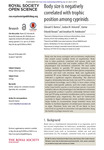Body size is negatively correlatedwith trophic position among cyprinids
| dc.contributor.author | Burress, Edward D. | en_US |
| dc.contributor.author | Holcomb, Jordan M. | en_US |
| dc.contributor.author | Bonato, Karine Orlandi | en_US |
| dc.date.accessioned | 2016-10-11T05:37:32Z | |
| dc.date.available | 2016-10-11T05:37:32Z | |
| dc.date.issued | 2016 | en_US |
| dc.identifier.other | HPU4160714 | en_US |
| dc.identifier.uri | https://lib.hpu.edu.vn/handle/123456789/23609 | en_US |
| dc.description.abstract | Body size has many ecological and evolutionary implications that extend across multiple levels of organization. Body size is often positively correlated with species traits such as metabolism, prey size and trophic position (TP) due to physiological and mechanical constraints. We used stable isotope analysis to quantify TP among minnows across multiple assemblages that differed in their species composition, diversity and food web structure. Body size significantly predicted TP across different lineages and assemblages, and indicated a significant negative relationship. | en_US |
| dc.format.extent | 9 p. | en_US |
| dc.format.mimetype | application/pdf | en_US |
| dc.language.iso | en | en_US |
| dc.subject | Biology | en_US |
| dc.subject | Ecology | en_US |
| dc.subject | Benthic–pelagic axis | en_US |
| dc.subject | Cyprinidae | en_US |
| dc.subject | Diet | en_US |
| dc.subject | Coevolution | en_US |
| dc.title | Body size is negatively correlatedwith trophic position among cyprinids | en_US |
| dc.type | Article | en_US |
| dc.size | 1.16MB | en_US |
| dc.department | Education | en_US |
Files in this item
This item appears in the following Collection(s)
-
Education [806]

